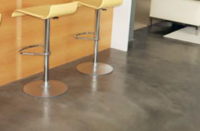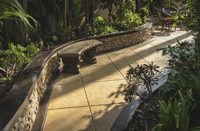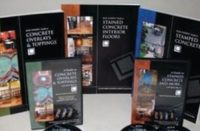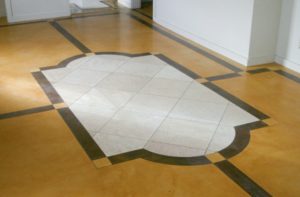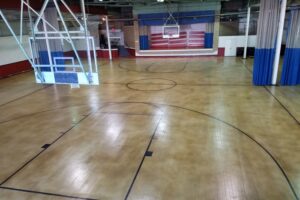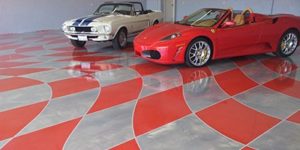
The Potawot Health Village in Arcata, Calif., greets patients with the look of a traditional Native American village, right down to the thick redwood planks that form the walls of the buildings.
Visitors might be even more impressed once they take a closer look at the redwood planks of Potawot. They aren’t wood at all — they’re tilt-up concrete.
 Sacramento contractor Concrete Surfacing Systems Inc. used reactive stains to duplicate redwood’s rich shades for the 12 buildings in the complex. “It looks exactly like wood,” says company president Rod Scott. “We actually had guys call us up saying they had walked up to a building and they could swear they could pound a nail into it.”
Sacramento contractor Concrete Surfacing Systems Inc. used reactive stains to duplicate redwood’s rich shades for the 12 buildings in the complex. “It looks exactly like wood,” says company president Rod Scott. “We actually had guys call us up saying they had walked up to a building and they could swear they could pound a nail into it.”
Scott and his crew photographed a preserved Indian village on state park land in Trinidad, Calif., to study the colors and textures of the historic buildings. “The huts were built out of redwood and carved with deer antlers,” Scott says. “Every plank was different.”
In many cases, Scott’s team simply duplicated the patterns of the wood, plank by plank, on the tilt-up structures. The colors of cut redwood, along with painted-on knotholes and other features, were recreated with an array of L.M. Scofield’s stains and dyes, supplied by Spec-West in Sacramento.
 Workers started by spraying a base coat of Antique Amber onto each wall, then applying several additional colors, including Faded Terracotta, Padre Brown, Black, and Fern Green. To apply these colors raggedly, in a way that would mimic the way they appear in wood, Scott and his crew developed their own handmade applicators. The team bought a slew of standard-issue window scrubbers from a home improvement chain store, then used razor blades and torches to cut and singe the soft end of the applicators to make them uneven. “We’d tear them up so they wouldn’t be the same as each other,” Scott says. “When all of them were used on a wall, they hit different spots every time.”
Workers started by spraying a base coat of Antique Amber onto each wall, then applying several additional colors, including Faded Terracotta, Padre Brown, Black, and Fern Green. To apply these colors raggedly, in a way that would mimic the way they appear in wood, Scott and his crew developed their own handmade applicators. The team bought a slew of standard-issue window scrubbers from a home improvement chain store, then used razor blades and torches to cut and singe the soft end of the applicators to make them uneven. “We’d tear them up so they wouldn’t be the same as each other,” Scott says. “When all of them were used on a wall, they hit different spots every time.”
The stainers tried to make each wall look like a unique set of panels. Muse Concrete Contractors Inc. of Redding, Calif., did its part to create the illusion by developing tilt-up wall forms that replicated the rough, uneven sides of the old huts.
 Scott’s crew stained 100,000 square feet of wall in a couple of winter months. It was foggy every day, Scott says, which was a problem, as moisture interferes with acid stain. “Some days we couldn’t work,” he says.
Scott’s crew stained 100,000 square feet of wall in a couple of winter months. It was foggy every day, Scott says, which was a problem, as moisture interferes with acid stain. “Some days we couldn’t work,” he says.
They also ran into a small snag when the stain didn’t take at spots on some of the panels. Power-washing the bald spots with TSP helped a second try stick. “We think all the release agent hadn’t gone away,” Scott says.
Wind was also a factor, especially since the crew wanted to keep acid-stain overspray off the metal roofs of the buildings. And just as the job was wrapping up, rain delayed application of the sealer for weeks. “Some sealer we had originally put down turned white,” he says. “We used dyes to fix it.”
 The 42,000-square-foot facility, which included the 12 buildings arranged in a circle, was built by United Indian Health Services. UIHS opened the complex in 2001 to serve nine tribes and more than 13,000 Native Americans.
The 42,000-square-foot facility, which included the 12 buildings arranged in a circle, was built by United Indian Health Services. UIHS opened the complex in 2001 to serve nine tribes and more than 13,000 Native Americans.
Concrete Surfacing Systems worked side by side with a tribal council to make sure the project went according to plan. The council kept a close watch, meeting with Scott every Friday, suggesting color touch-ups on individual walls and stringently monitoring disposal of stain runoff. The complex was built on tribal wetlands, and any ground contamination was unacceptable. “One thing they said was, ‘For sure we’re going to test,'” Scott remembers.
 In fact, what Scott says he treasures the most from the experience was his clients’ appreciation. “We got a letter from the Indian council saying they were glad they picked us as contractors,” he says. “They had to all like it. That was hard. But the buildings look so much like huts, they couldn’t say anything. It was perfect.”
In fact, what Scott says he treasures the most from the experience was his clients’ appreciation. “We got a letter from the Indian council saying they were glad they picked us as contractors,” he says. “They had to all like it. That was hard. But the buildings look so much like huts, they couldn’t say anything. It was perfect.”
Scott also credits Arcata-based Mayan Construction, the project’s general contractor, with making his job easier. “He got everybody out of our way,” he says. “He knew what we were doing was very artistic. A job like this couldn’t have been done without total cooperation.”
